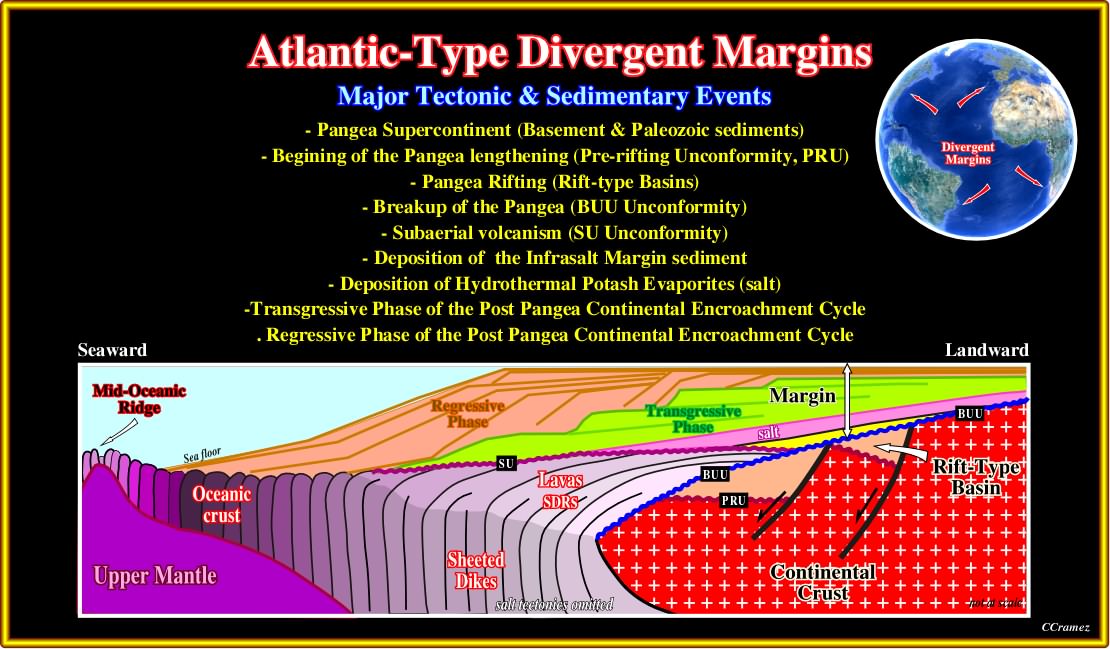

This is the Home Page of a conference on "Atlantic-Type Divergent Margins". Here, you find, the less falsifiable hypothesis explaining the origin of these continental margins, which are, by far, volcanic in nature and the more significant tentative geological interpretations of seismic line on. All proposed tentative interpretations are personal and do not engage, in any way, the companies owners of the original lines.
If you click on the interlinks (underlined text and bots), you can navigate and you will find a text and the majority of the plates shown during these conference.

This schematic geological cross-section of Angola offshore is representative of the Atlantic-type divergent continental margins. It illustrates the main geological features allowing the understanding of the different petroleum systems present on these margins : (i) Pre-Pangea Sediments (Basement and / or Paleozoic sediments), which are limited by the pre-rifting unconformity (PRU) ; (ii) The Rift-type Basins, developed during the lengthening of the Pangea supercontinent ; (iii) The Breakup Unconformity (BUU), which corresponds to the breakup of the Gondwana lithosphere and highlights the upper limit of the rift-type basins, in which organic rich (organic matter type I) lacustrine shales (parallel internal configuration) are potential source-rocks ; (iv) The BUU Unconformity is fossilized by the SDRs (subaerial volcanism) or by the margin subsalt sediments ("sag basin" of some American geoscientists) ; (v) The SDRs (seaward dipping reflectors), which correspond to subaerial lava flows poured out of the subaerial expansion centers and flowing outward in direction of the individualized continents (admittedly they are considered as incapable of generate hydrocarbons) ; (vi) The Angola-Congo salt basin, which is a twin of the Brazilian salt basin, that is to say, that it has always been individualized and never connected with the Brazilian salt basin; (vii) The Transgressive (backstepping) and Regressive (forestepping) phases of the post-Pangea continental encroachment cycle ; (v) The potential marine source-rocks (organic matter type-II), in association with the interface between the transgressive and regressive phases ; (vi) Potential dispersive source rocks (organic matter type III) within the in the regressive interval, etc.
click on the underlined text
Atlantic-Type Divergent Margins
by
Carlos Cramez

In addition to "Divergent Continental Margins Atlantic-Type" , the following short-courses are available :
- Glossary of Salt Tectonics ;
- Basic Principles in Tectonics ;
- Bassins Sédimentaires et Systèmes Pétroliers ;
- Salt Tectonics ;
- Seismic Interpretation ;
- Systemic Stratigraphy Seminar ;
- Foredeep & Fold Belts ;
- Volume Problems ;
- Hydrodynamism ;
- Turbidite Systems ;
- Sequence Stratigraphy;
- Rocky Mountains ;
- Offshores Profonds ;
- Glossary in Sequential Stratigraphy.
Send E-mail to carloscramez@gmail.com with questions or comments about these notes (Altlantic-type Divergent Continental Margins).
Copyright © 2012 CCramez
Last modification: July, 2014